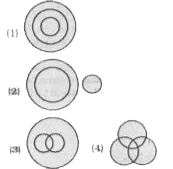Identify the sequence of steps of nitrogen cycle showing relationship between the three main nitrogen pools-atmospheric, soil and and biomass.
Atmosphere N2→soil N2 Pool → plant biomass→animal biomass→decayng biomass
Animal biomass→decaying biomass→plant biomass→soil N2 Pool →atmospheric N2
Soil N2 Pool → atmospheric N2→decaying biomass→animal biomass
none of the above
The correct Answer is:A
Step-by-Step Solution for the Nitrogen Cycle
1. Atmospheric Nitrogen (N₂) Fixation:
- The nitrogen cycle begins with atmospheric nitrogen, which is abundant in the atmosphere but not directly usable by most living organisms.
- Nitrogen fixation occurs, where atmospheric nitrogen is converted into ammonia (NH₃) by nitrogen-fixing bacteria (biological fixation) or through non-biological processes like lightning.
Hint: Remember that nitrogen fixation is essential for converting atmospheric nitrogen into a usable form for plants.
2. Conversion to Soil Nitrogen:
- The ammonia produced is then converted into nitrites (NO₂⁻) and nitrates (NO₃⁻) through a process called nitrification, facilitated by nitrifying bacteria in the soil.
- This process enriches the soil nitrogen pool, making it available for plant uptake.
Hint: Nitrification is crucial as it transforms ammonia into forms that plants can absorb.
3. Plant Uptake:
- Plants absorb nitrates from the soil through their roots. This is the primary way plants obtain nitrogen, which is essential for their growth and development.
- Once absorbed, nitrogen is incorporated into amino acids, proteins, and nucleic acids within the plant biomass.
Hint: Focus on how plants are the primary producers that convert nitrogen into organic forms.
4. Animal Biomass:
- Herbivores (primary consumers) eat the plants and obtain nitrogen from the plant biomass. This nitrogen is then used to build their own proteins and nucleic acids.
- Carnivores (secondary consumers) obtain nitrogen by consuming herbivores.
Hint: Animals rely on plants for nitrogen, highlighting the interdependence in the ecosystem.
5. Decaying Biomass:
- When plants and animals die, their bodies decompose. Decomposers like bacteria and fungi break down the organic matter, releasing nitrogen back into the soil in the form of ammonium (NH₄⁺) through a process called ammonification.
- This process returns nitrogen to the soil nitrogen pool.
Hint: Decomposition is vital for recycling nutrients back into the ecosystem.
6. Return to Atmospheric Nitrogen:
- Some nitrogen in the soil is converted back to atmospheric nitrogen through denitrification, a process carried out by denitrifying bacteria. This completes the nitrogen cycle by returning nitrogen to the atmosphere.
Hint: Denitrification is the final step that ensures nitrogen is cycled back into the atmosphere.
Summary of the Sequence:
1. Atmospheric Nitrogen (N₂)
2. Soil Nitrogen (NH₃, NO₂⁻, NO₃⁻)
3. Plant Biomass
4. Animal Biomass
5. Decaying Biomass
6. Return to Atmospheric Nitrogen
Final Answer:
The correct sequence of the nitrogen cycle showing the relationship between the three main nitrogen pools (atmospheric, soil, and biomass) is:
- Atmospheric Nitrogen → Soil Nitrogen → Plant Biomass → Animal Biomass → Decaying Biomass → Atmospheric Nitrogen.
- The nitrogen cycle begins with atmospheric nitrogen, which is abundant in the atmosphere but not directly usable by most living organisms.
- Nitrogen fixation occurs, where atmospheric nitrogen is converted into ammonia (NH₃) by nitrogen-fixing bacteria (biological fixation) or through non-biological processes like lightning.
- The ammonia produced is then converted into nitrites (NO₂⁻) and nitrates (NO₃⁻) through a process called nitrification, facilitated by nitrifying bacteria in the soil.
- This process enriches the soil nitrogen pool, making it available for plant uptake.
- Plants absorb nitrates from the soil through their roots. This is the primary way plants obtain nitrogen, which is essential for their growth and development.
- Once absorbed, nitrogen is incorporated into amino acids, proteins, and nucleic acids within the plant biomass.
- Herbivores (primary consumers) eat the plants and obtain nitrogen from the plant biomass. This nitrogen is then used to build their own proteins and nucleic acids.
- Carnivores (secondary consumers) obtain nitrogen by consuming herbivores.
- When plants and animals die, their bodies decompose. Decomposers like bacteria and fungi break down the organic matter, releasing nitrogen back into the soil in the form of ammonium (NH₄⁺) through a process called ammonification.
- This process returns nitrogen to the soil nitrogen pool.
- Some nitrogen in the soil is converted back to atmospheric nitrogen through denitrification, a process carried out by denitrifying bacteria. This completes the nitrogen cycle by returning nitrogen to the atmosphere.
1. Atmospheric Nitrogen (N₂)
2. Soil Nitrogen (NH₃, NO₂⁻, NO₃⁻)
3. Plant Biomass
4. Animal Biomass
5. Decaying Biomass
6. Return to Atmospheric Nitrogen
The correct sequence of the nitrogen cycle showing the relationship between the three main nitrogen pools (atmospheric, soil, and biomass) is:
- Atmospheric Nitrogen → Soil Nitrogen → Plant Biomass → Animal Biomass → Decaying Biomass → Atmospheric Nitrogen.
Similar Questions
Knowledge Check
In nitrogen cycle, the main products are
ANOandNO2BNO2andN2O3CNOandN2O3DN2O3andN2O5A sequence of three Nitrogen Bbase of RNA can function as :-
AGeneBNucleosideCCodonDAmino acidIdentify the diagram that best represents the relationship among the classes given.
Nitrogen, Air, IceA B
B C
C D
D
Draw diagram of (i) nitrogen cycle, (ii) carbon cycle.
View SolutionWhat is the relationship between water-fern (Azolla) and nitrogen-fixing cyanobacteria (Anabaena) called?
View SolutionIdentify the correct sequence of steps in an experiment to show the effect of temperature on the rate of the reaction.(1) Measuring the volumes of H2 gas liberated in the two test tubes.
(2) Heating the test tube B by 10∘C
(3) Comparison of relative volumes of H2 liberated in test tubes B and A.
(4) Addition of same concentration of HCl ot the two test tubes.
(5) Taking equal masses of fine granules of zinc in two test tubes A and B.
View SolutionAssertion. Nitrogen and oxygen are the main components in the atmosphere but these do not react to form oxides of nitrogen.
Reason. The reaction between nitrogen and oxygen requires high temperature.
View SolutionAssertion. Nitrogen and oxygen are the main components in the atmosphere but these do not react to form oxides of nitrogen.
Reason. The reaction between nitrogen and oxygen requires high temperature.
View Solution


